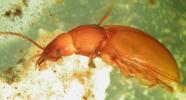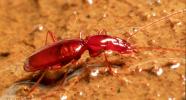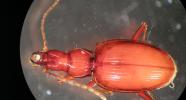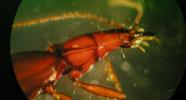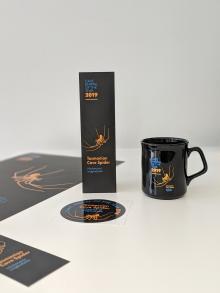
Cave beetle
Welcome to Cave Animal of the Year.
This exciting program commenced in Australia on 3 January 2019 and is modelled on the German Cave Animal of the Year program which has been going since 2009. We thank our German friends for their encouragement and support.
Why Cave Animal of the Year?
Cave animals are generally inconspicuous small creatures, rarely seen and rarely thought about by the human community. But hidden away in the darkness of caves are amazing animals which have adapted to the underground world of little to no light.
Cave Animal of the Year seeks to celebrate the wonders of cave animals, encourage people to learn more about them and build an increased awareness of caves as important wildlife habitat.
Beetle power
With over 400,000 described species about a quarter of animals on planet Earth today are beetles and they live in a wide range of habitats including the dark world of caves.
Many species of beetles can be found in Australian caves and about 25 of these are troglobitic, meaning that they are specialised for underground life and not found above ground. Most troglobitic beetles in Australia are short-range endemics, typically restricted to a single cave or karst system. Tasmania has the richest cave beetle fauna in Australia, with around 17 described species, and several more known but not yet described.
The other troglobitic Australian cave beetle species are known from Victoria, New South Wales, South Australia and the Nullarbor karst (South Australia–Western Australia).
Troglobitic beetles are relicts which were isolated underground when conditions on the surface changed over millenia, either increasing aridity or glaciation, which caused the loss or reduction of the beetle ancestor’s moist forest-floor habitat.
Not all cave beetles are troglobitic
There are numerous other beetles living in caves which are not troglobites but are troglophiles (the term for cave animals that can also be found above ground) and/or guanophiles (the term for cave animals that live and reproduce within guano piles—the mounds of bat excrement that build up in caves).
The science of biospeleology has its origins with a troglobitic cave beetle
While the first documentation of a cave animal dates to 1689, the first formal study of a cave animal was on a troglobitic blind cave beetle found in 1831 in Postojna Cave, in what is now south-western Slovenia, and described in a research paper in 1832. This description is now recognised as the commencement of biospeleology as a scientific discipline.
The beetle was named Leptodirus hochenwartii and its common name is the slender-necked beetle.
There’s a whole world of cave beetles
As you can see from this brief introduction, there are many beetles that live in caves and other underground habitats in Australia. And this diversity of cave beetles is repeated around the world.
Cave animals come in three broad groups
Caves offer habitat for many kinds of animals and cave animals are divided into three groups:
- They live solely in caves and might have special adaptions for underground life. These are troglobites and are generally not found above ground.
- Can live all or part of their lives in caves. These are troglophiles and these may live all or part of their lives in caves but can also complete a life cycle in suitable surface locations. The 2019 Australian Cave Animal of the Year, the Tasmanian Cave Spider is a troglophile—it can live its whole life in a cave but could also live its whole life in a suitable place outside a cave such as inside a tunnel or in a rainforest with suitable ‘hidey-holes’ such as tree hollows.
- Frequent caves but must return to the surface for at least part of its life, these are trogloxenes and can include animals such as wombats and owls. Think of these as a ‘cave guest’.
There’s a large range of beetles in Australian caves!
Troglophilic and guanophilic beetles include species in the families Staphylinidae (rove beetles), Ptinidae and Tenebrionidae. The large tenebrionid Brises nullarboricus (a common troglophile/guanophile in Nullarbor caves) and its sister species, Brises katherinae, occurs in the Katherine Caves, Northern Territory.
Sometimes found in caves are dung beetles (family Scarabaeidae) which feed on animal dung and hide beetles (Trogidae) which are scavengers on animal carcasses. Weevils (Curculionidae) may sometimes be found in caves, especially on tree roots on which they feed.
Many other beetles are predators, including members of the family Carabidae. Most of the specialised beetle troglobites found in limestone caves are Carabidae, however troglobitic species of Staphylinidae, Pselaphidae, Cryptophagidae, Curculionidae, Dytiscidae, Elmidae, and Psydrinidae are also known from groundwater aquifers and meso-caverns in non-limestone rocks and are diving beetles.
Aquatic cave beetles live in springs and groundwater, are predominately from the family Dytiscidae and are predatory in both their larval and adult forms. They require air to breathe and must access the water surface every 30 minutes to 1 hour. The greatest diversity of stygobiontic dytsicids in the world are within calcrete aquifers in arid Western Australia.



